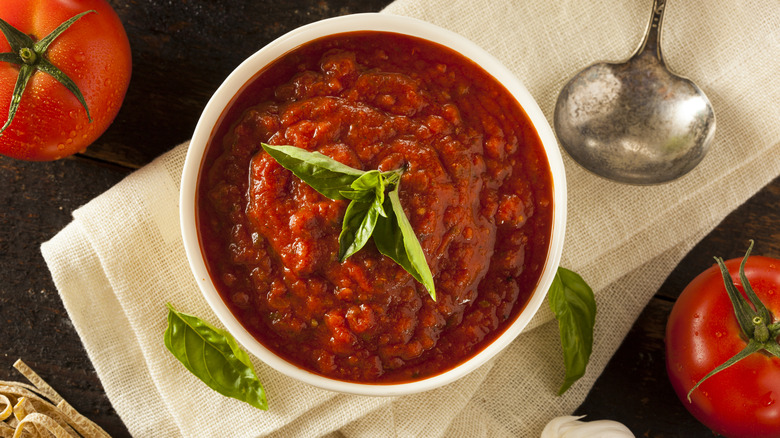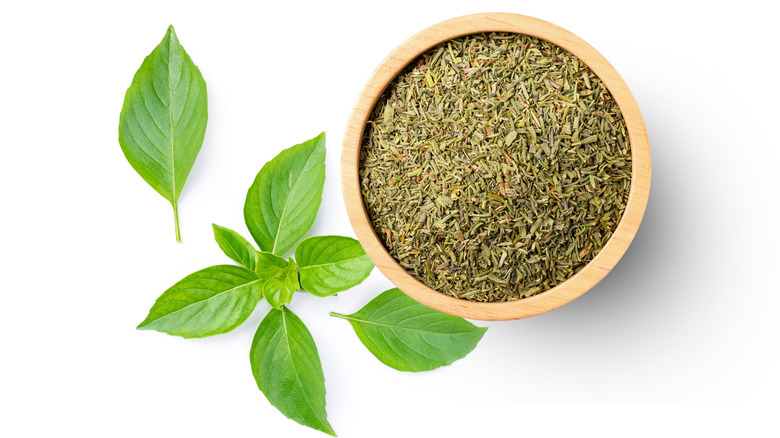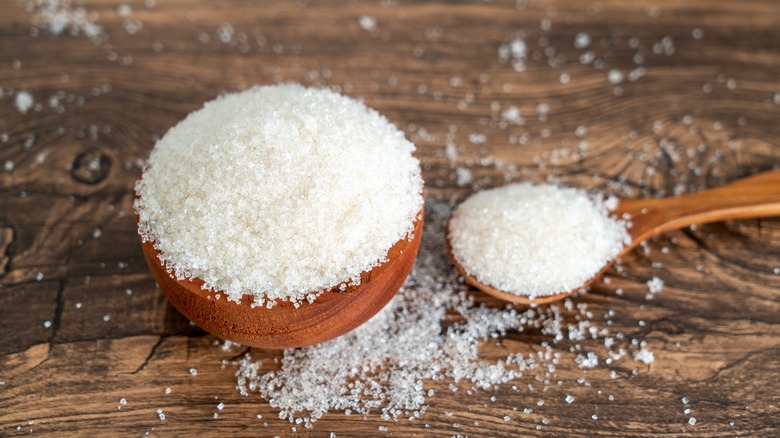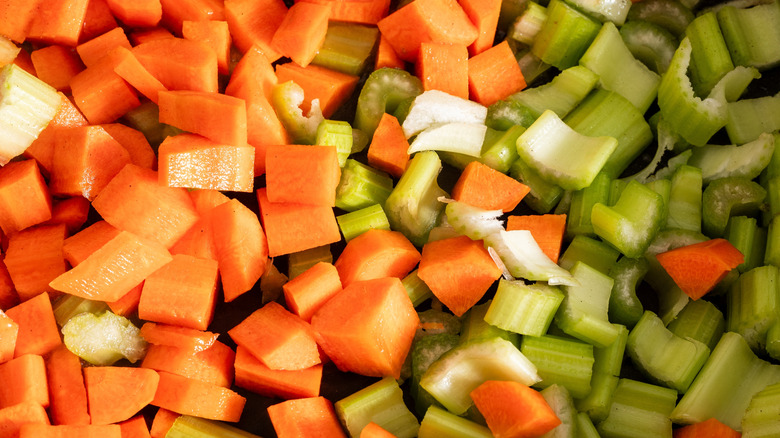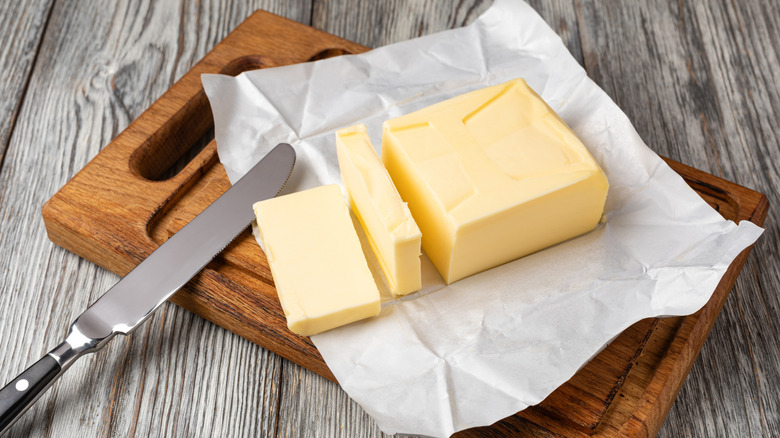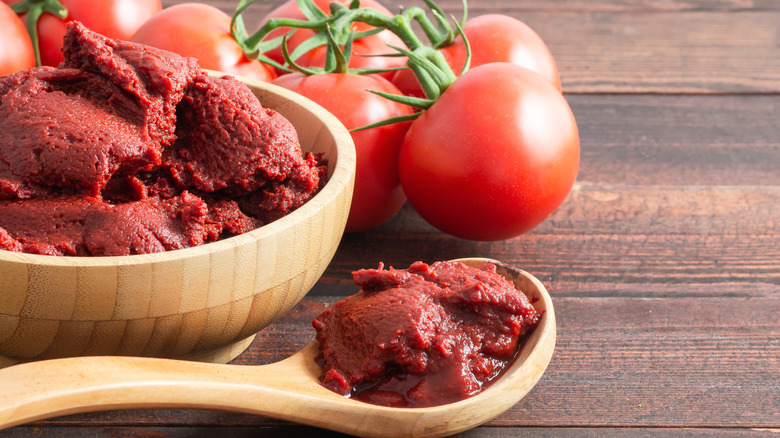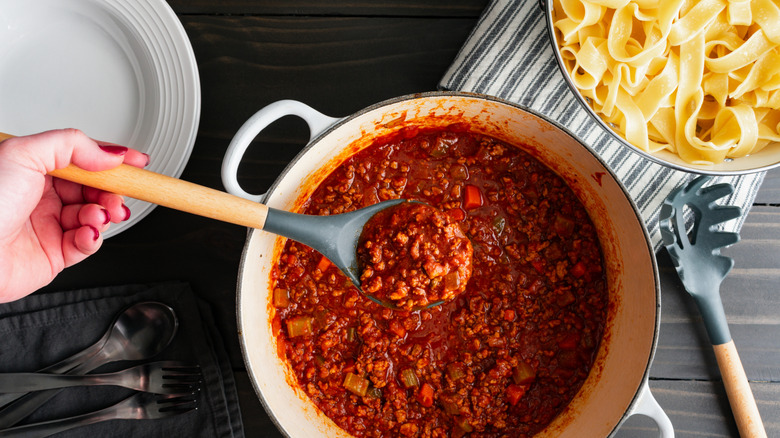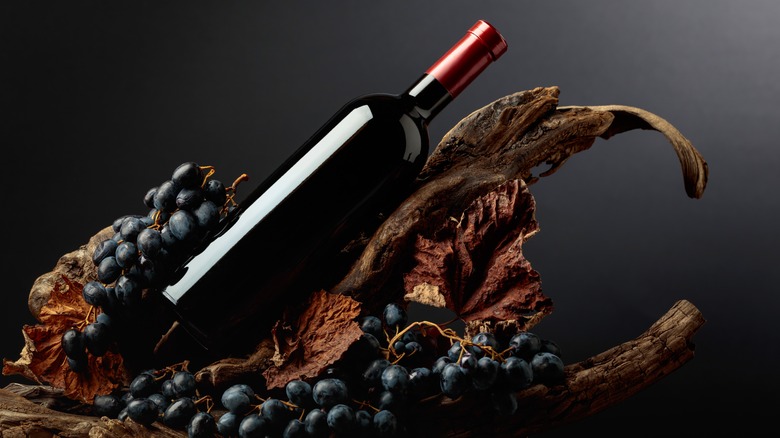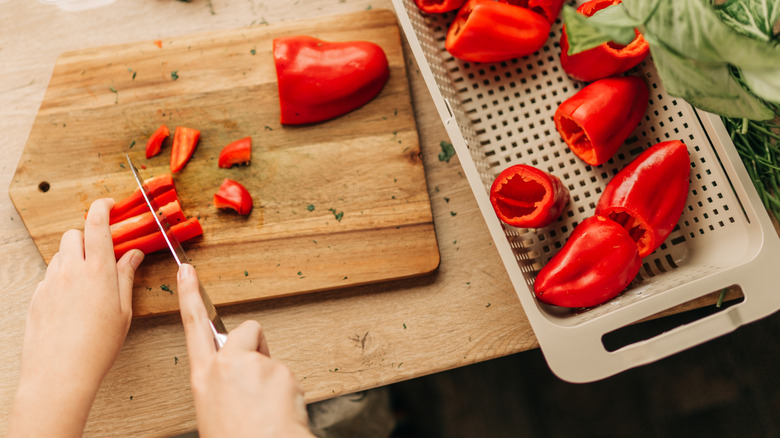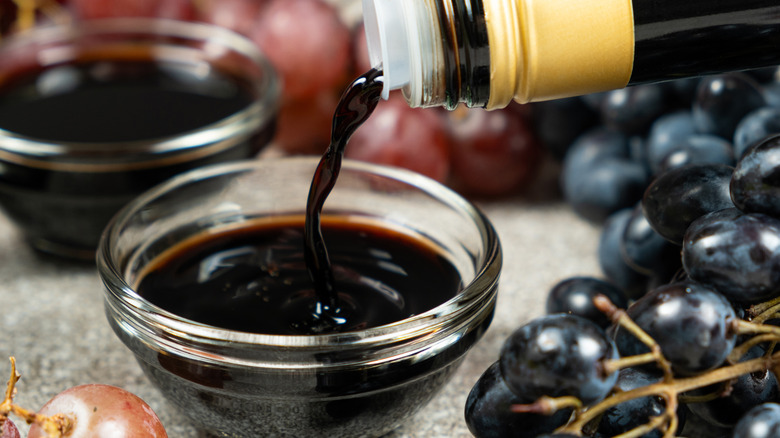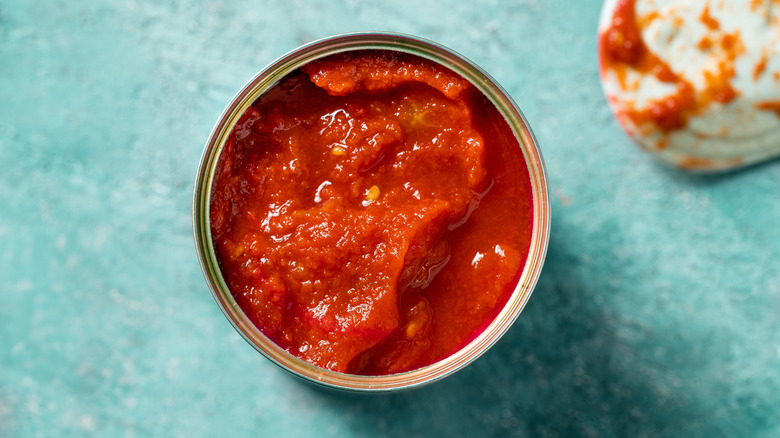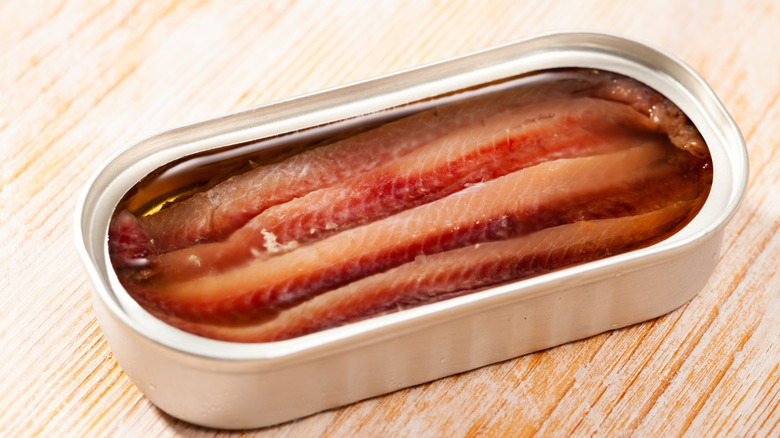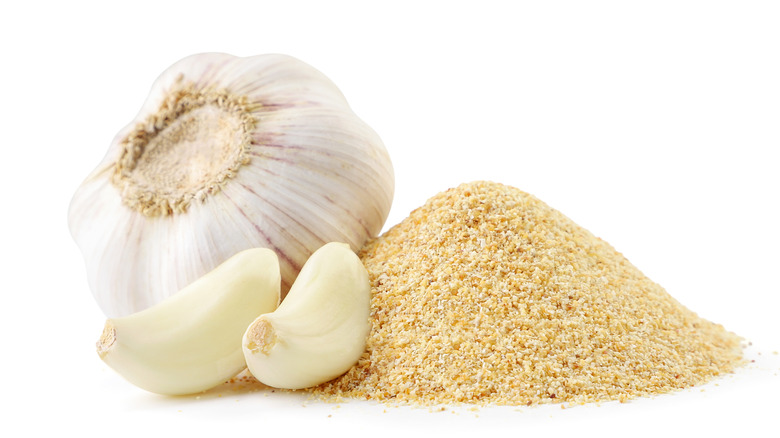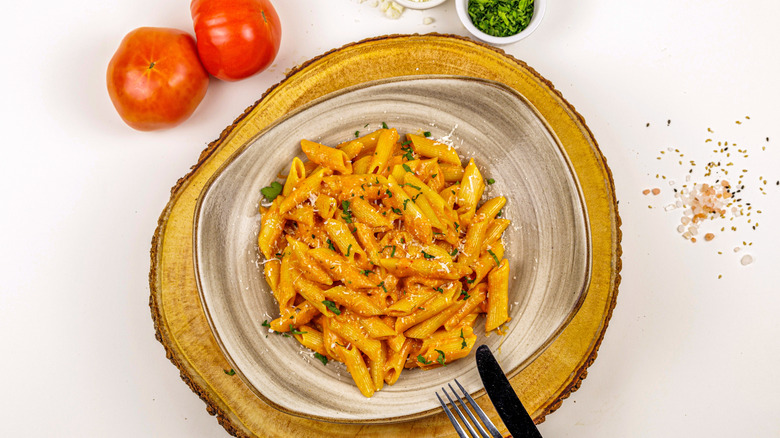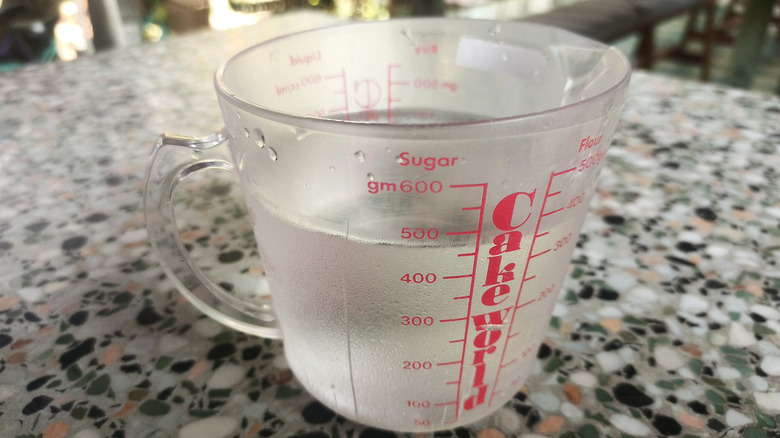14 Ingredients You Should Never Put In Marinara Sauce
Good marinara sauce should be simple, but so many cooks try to overcomplicate it. You want the tomatoes to be the focus, keeping unnecessary additions away. But there are some ingredients you should never put in marinara sauce that many people do. If you want to up your game and make a classic sauce, it's important to know what not to use.
As a food writer from an Italian background, to say I'm familiar with marinara is an understatement. But, I also interviewed four chefs and one recipe developer to get all the information I needed to write this piece. There were only a handful of ingredients that all our chefs agreed should go in a marinara sauce: tomatoes, fresh garlic, quality olive oil, salt, and fresh basil. Outside of that, you're in dangerous territory.
Italian food is all about delicious simplicity, so keep those extras out. If you want your marinara sauce to taste like someone's nonna made it, here are the ingredients you should avoid.
1. Dried basil
For marinara sauce, fresh basil is where it's at. Keep the dry stuff away. Actually, I would go as far as to say that there's never a place for dried basil. When fresh, this is one of the most fragrant, intensely flavored herbs, but the dried version tastes like dust and sadness.
Chef Matthew Cutolo of Gargiulo's in Coney Island says that it just doesn't work. "Dried basil has a completely different flavor — more muted, even dusty," he tells us. "Fresh basil gives marinara its signature aroma and finish." So step away from your pantry and put that old bottle of herbs down.
All our experts talk about using fresh basil in their sauce. Chef Renee Guilbault, CEO of Harry's Famous Sauce, recommends that fresh basil should be torn, not cut, to better release the aromatic oils and make it more flavorful. She adds that "a sprig or two of fresh oregano can also be lovely, but use it sparingly, as it can be quite assertive and take over the balanced flavor of the marinara." Some cooks are down with oregano in marinara whereas others think it makes it taste like pizza sauce and is best avoided, so use it with caution.
2. Sugar
You want a sweetness to a quality marinara sauce, but this shouldn't come from added sugar. Sure, if you get to the end of cooking and something tastes off, then it might seem like a pinch of sugar would balance things out, but if you need to add a sweetener, it means something has gone awry.
Ciro Fodera, executive chef at Capo Restaurant & Supper Club in Boston insists sugar is an unnecessary addition. "Sugar is used to mask the lack of quality ingredients," he explains. "If you use San Marzano tomatoes there's no need to use sugar as the natural sugar and acidity will do the job."
Chef Glenn Rolnick of Carmine's in New York City and chef Matthew Cutolo both echo the sentiment that good tomatoes are what you need to end up with the right amount of sugar, not added sweetness. Many of our experts go for San Marzano tomatoes, which are the gold standard when making marinara sauce. However, to be sold under this name, they have to be grown in Italy, which some chefs think is a waste of air miles.
Although Renee Guilbault of Harry's Famous Sauce uses San Marzano-style tomatoes, she looks closer to home. "I like to buy U.S.-grown tomatoes because frankly, as a trained chef, I am very aware that tomatoes are native to the Americas, and there is no need to ship tomatoes from overseas to achieve that gorgeous sweetness we all expect from a fresh, delightful marinara."
3. Carrots, celery, and onions
Carrots, celery, and onions, make up what's known as a soffritto in Italian cooking. It's also called a mirepoix in French cuisine. These aromatic ingredients are used as the base for many sauces — but not for marinara, which is meant to be a simple affair. Sure, you'll occasionally find them in this type of sauce, but most of our experts agree they should be left out, especially if you want a classic version.
Celery and carrots "belong in a soffritto for Bolognese, not marinara," Matthew Cutolo of Gargiulo's tells us. While Marissa Stevens, recipe developer and food blogger at Pinch and Swirl, uses carrots in some pasta sauces, she doesn't in this one. "They throw off the texture and add an earthy-sweet flavor that doesn't fit," she notes.
Onions are a bit more controversial, as some people use them in marinara, but really this sauce should be quick and simple. "While onions are great in vodka sauces, ragù, or Bolognese, they're not needed in marinara and can shift the flavor in the wrong direction," says Glenn Rolnick, chef at Carmine's.
4. Butter
You need fat in a marinara sauce, but it shouldn't come from butter. While it's not unheard of to use butter in Italian cuisine, especially in the North of the country, olive oil is the more common choice. Ultimately, it just doesn't belong in marinara.
Matthew Cutolo of Gargiulo's says butter belongs in vodka sauce or pomodoro sauce but "marinara should stay light and olive oil-based." Marissa Stevens agrees, saying that butter makes the sauce too soft. "It's lovely in other tomato sauces (like Marcella Hazan's famous version), but not for marinara," she remarks.
According to executive chef Ciro Fodera, some chefs finish marinara off with a pat of butter, but it isn't a necessary addition. Rather, all our experts recommended using a high quality olive oil. "A good quality extra-virgin olive oil is paramount — the kind that smells of green olives and a touch of pepper," remarks chef Renee Guilbault.
Some don't go for extra-virgin (though it is fine to cook with, contrary to popular belief) but quality is always on the agenda. You should avoid cheap olive oil for many reasons, not least because it just doesn't taste as nice as the good stuff. It's definitely the kind of ingredient that's worth splurging on, especially in a sauce as simple as marinara.
5. Tomato paste
Tomatoes are important in marinara sauce. But tomato paste? You should be leaving that one for another recipe. You don't need it in this sauce — and actually it's going to make the whole thing worse.
"Marinara should be fresh and light," explains recipe developer Marissa Stevens. "Tomato paste makes the sauce taste more cooked than it should," she adds. Chef Ciro Fodera of Capo Restaurant and Supper Club agrees that tomato paste shouldn't go in this sauce. It provides more tomato flavor, but you don't need this if you use high quality tomatoes. "San Marzano tomatoes are more than sufficient in providing the tomato flavor of a great marinara," he remarks.
When you use tomato paste, you lose the brightness you want from a marinara. It's more in keeping with a slow cooked sauce that might have been simmering away all day. Save it for a more intense recipe.
6. Meat
Some people like meat in their red sauces. It's a classic Italian staple. But is it a marinara sauce? No. Marissa Stevens of Pinch and Swirl puts it simply: "Once you add meat, it's meat sauce — not marinara."
Adding meat to a pasta sauce makes it a ragù. And no, we're not talking about the brand Ragù, which is generally better left on the shelf. There are lots of types of ragù recipes, including sausage ragù and, of course, a classic Bolognese. And there's nothing wrong with making these kinds of dishes, they just don't fall into the marinara category.
The truth of marinara sauce is that it's simple. Most of the experts we spoke to listed just five ingredients — tomatoes, olive oil, salt, basil, and garlic. It's a sauce you should keep at its most basic, and in doing so, let every flavor speak for itself.
7. Wine
Wine is "great in a slow-simmered sauce, but not traditional in a quick marinara," says chef Matthew Cutolo. None of our experts listed wine as an ingredient they'd use in a marinara sauce, and three of them specifically listed it as an ingredient you should avoid.
According to Ciro Fodera, wine adds extra acidity to sauce. And in the case of marinara, this isn't what you want. It doesn't cook for a long time, so there aren't those extra hours in which sugars can concentrate, providing enough sweetness to balance out this extra acidity. Wine also adds a richness and depth that can be delicious but isn't what you want from a bright, fresh marinara.
So, we're not saying to avoid wine in red sauces altogether, just to give it a rest when making marinara. Red wine adds a deepness to Bolognese and other slow-cooked sauces that you can't get elsewhere. White wine is a little fresher yet still works in tomato sauces. But when you do choose to use it in other sauces, there are some big mistakes to avoid when cooking with wine. Ultimately, it's a no-go for marinara but delicious in general.
8. Bell peppers
It might seem obvious, but bell peppers shouldn't go anywhere near your marinara sauce. Yes, they're red, but that doesn't mean you can use them in addition to tomatoes. Maybe you like the extra flavor they bring, and that's fine, but if it contains bell peppers, it isn't a marinara sauce, it's something else.
"Bell peppers add a sharp, tangy flavor that's much too strong for marinara," says recipe developer Marissa Stevens. "They take over," she explains. There's a time and a place for bell peppers. They taste great and they're nutritious, but when you're looking to make classic marinara sauce, you've got to let them go. A roasted bell pepper pasta sauce, for instance, is delicious, but it's a different beast altogether.
It's also worth noting here that red pepper flakes don't belong in marinara, either. These come from hot peppers rather than bell peppers, but they're still not right for this sauce. They add a kick that isn't traditional.
9. Balsamic vinegar
You might think that balsamic vinegar will add a pleasant tang of acidity to your marinara sauce, but you don't need it. You should already have the right balance of sweetness and tartness in the sauce, so adding extra acidic ingredients will throw it off.
According to Matthew Cutolo of Gargiulo's in Coney Island, balsamic vinegar has the wrong flavor profile for this sauce. "It's acidic and sweet in the wrong way," he says. You might think it's only going to boost those existing notes, but actually it can skew them in the wrong way. "I've seen it in recipes and tried it once," Marissa Stevens tells us. But she says that she'll never use it again: "It's too sweet and distracts from the tomatoes."
Balsamic vinegar should stay out of marinara sauce, but so should other vinegars and lemon juice. Messing with the balance of sour ingredients can leave you with a sauce you wouldn't be proud to serve.
10. Canned tomatoes that contain extra ingredients
Look at the tomatoes you choose. There should be nothing but tomatoes themselves in there. If they contain any other ingredients, they're not right for marinara sauce. You want to build the flavors yourself, rather than using flavored tomatoes.
Chef Matthew Cutolo warns against canned Italian style tomatoes. "These are pre-seasoned with dried herbs and garlic powder," he says, adding that "you lose all control over flavor." Even if the tomatoes you buy contain ingredients that belong in marinara sauce, like basil, olive oil, or garlic, it's just not the same. You won't get the same results as using fresh ingredients.
But the tomatoes themselves needn't be fresh. In fact, in many cases, you get better results with canned tomatoes than fresh ones. "Unless they're peak-season, garden-grown, fresh tomatoes often lead to bland, watery sauce," Cutolo tells us. "High-quality canned San Marzanos are better 90% of the year."
If you're wondering what it is with this type of tomato, Ciro Fodera of Capo in Boston explains. "San Marzano tomatoes have a lower water content and less seeds compared to other breeds of tomato," he says. "Less water equals more concentrated rich tomato flavor." But other quality plum tomatoes will also do the trick.
11. Anchovies
Anchovies are known for adding umami to dishes, but it's not the right call for a marinara sauce. These little fish have an intense flavor that's definitely going to come through in the finished dish. And, we probably don't have to make this any clearer, but simplicity is the order of the day for marinara.
The fact is, anchovies or anchovy paste are "delicious in a puttanesca, but way too salty and pungent for a clean marinara," explains chef Matthew Cutolo. Ciro Fodera agrees, saying "you start to deviate when you start to put anchovies in marinara." And this is true — it might bring flavor, but you're starting to make another dish. Delicious? Maybe, but marinara it is not. "While the anchovies will add more complexity and salt, the marinara will lean towards a puttanesca," notes Fodera.
There's a place in a red sauce for anchovies, but don't add them and call it a marinara. You end up with a sauce that's too deep and punchy. What you're going for here is something with more freshness to it.
12. Garlic powder
All our experts agreed that marinara sauce needs garlic, but don't even think about using garlic powder. Doing so will likely immediately exempt you from ever gaining an Italian visa. And that's before you even get to the fact that you're doing yourself a disservice by not making your sauce as good as it could be.
"If there's one thing you don't shortcut here, it's that quick fresh garlic sizzle in oil," says recipe developer Marissa Stevens. There really is no substitute for fresh garlic. The dried and powdered stuff is simultaneously more pungent and less complex, so you get the punch of garlic without those subtle sweet notes that make it so delicious.
Fresh garlic it is then, but how do you prepare it? Many people opt for thinly sliced, but Harry's Famous Sauce CEO and chef Renee Guilbault says it can be "thinly sliced or minced, depending on your preference for a more robust or subtle flavor." Mincing will give you a more subtle, evenly distributed garlic flavor throughout, whereas slicing gives you stronger hits of the stuff.
13. Cream
Thinking of using cream in your marinara sauce? Think again. If you actually want a rosé sauce or a creamy pasta sauce, pouring cream in and letting it simmer lightly will give you something delicious. But it absolutely won't be a classic marinara anymore, so if that's what you're aiming for, step away from the dairy.
"The second cream hits the pot, you're making a vodka or rosé sauce — not marinara," says Gargiulo's chef Matthew Cutolo. So, it's all about intention. It's not wrong to add cream to a tomato-based sauce if that's what you want. But it is wrong to add cream and call it a marinara.
Food blogger Marissa Stevens agrees that "cream completely changes the sauce." She says "it's not the flavor or mouthfeel you want in marinara." Don't be afraid to add cream to make yourself a rosé sauce or similar. If you prefer it to a straight up marinara, then great — it's easy to rectify. But don't follow a recipe that claims to be a basic marinara sauce but includes cream. That's not the vibe you should be going for.
14. Water
Some people put water in marinara sauce, presumably to make it go further or to thin it out, but this really defeats the purpose. You want your sauce to be as flavorful as possible and water is only going to dilute it. So, it's an ingredient you should always steer clear of.
As Capo Restaurant & Supper Club's executive chef Ciro Fodera explains, the tomato juice from the can, along with the liquid in the tomatoes themselves are all you need to make the sauce the correct consistency. "Water is the enemy when it comes to concentrating flavor," he says. "You are essentially diluting the natural flavors by adding water, which in turn means a longer cooking time if you are trying to get the most flavor possible from the tomatoes."
If you're using the sauce on pasta and find it a little too thick, you can always add a little of the pasta cooking water to thin it out when you mix the sauce and noodles together. Pasta cooking water is salty and full of starch from the noodles, so it's a better contender than plain water, giving you a silky finish and a flavorful sauce.
